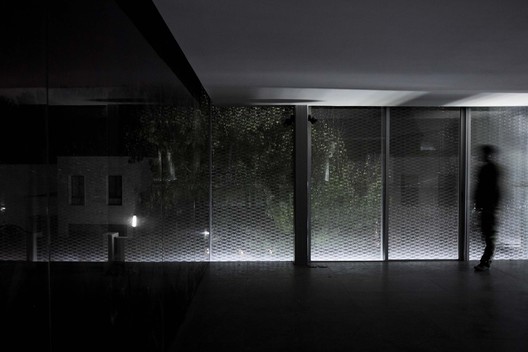
-
Architects: reMIX studio
- Area: 1100 m²
- Year: 2018
-
Photographs:Federico Ruberto

Text description provided by the architects. The project is an extension designed to host private residential spaces as well as spaces for a local artists community. The intervention connects and mediates the presence of two existing volumes; it grows around the two separated units generating different light conditions, fusing in a non-linear sequence the existing programs and the “new”, which comprises of creative disciplines such as sculpting, painting, pottery. The volumes weave around in their bare materiality enveloping more private and secluded spaces, interiors that are of three types: meditation, rest and discussion.

The volumes overground are defined by layers that, keeping a calculated balance between dissolution and solidification, work mainly on one function: mediating and organizing through few formal gestures the “incalculable”: light. The composition, texture and density of the facades result from the interpolation of three parameters: degree of reflection/refraction of direct light (artistic requirements, maximization of view from interior to exterior (living requirements, and minimization of visual permeability from exterior to interior (privacy.



Materials are kept to the bare minimum; anodized aluminum envelops all the new overground terraces and glass volumes, whilst rough concrete defines the underground spaces. The program has no identifiable divisions, no internal boundaries define the newly inserted activities, which are diluted by light and transformed into programmatic gradients. For this reason each space (spatial sequence is surrounded by a continuous system, a porous envelope made by glass and several layers of a differently oriented mesh —superimposed sheets that have apertures and densities varying according to specific requirements.


This operation generates different degrees of visual permeability, reflection and ultimately privacy. The new addition appears solid in volume/color/texture if looked from the outside, but it visually vanishes when "lived" from the inside, an effect generated by the juxtaposition of differently oriented layers of stretched aluminum mesh that “opening up” or “closing down” force the eyes to see trough or not, to catch peculiar reflections according to where they are placed.

The landscape around the building [unfinished at this stage] is supposed to work formally in continuity with the architectural mass, establishing ground links between the two poles of the plot. The material simplicity of the hardscape -wooden deck and aluminum mesh, works in conjunction with a less formally determined softscape which has set plants and groups of essences placed emphasizing the presence of water, the amount of solar irradiation, and the desired degree of privacy from the surroundings.

At the moment there is no effective presence of vegetation on the elevated terraces and on the facades, this is because time has not yet run its course. By the end of summer we expect to be able to catch layers of vegetation expanding all around the building, growing from the elevated terraces that have embedded soil containers along their perimeters, and from the base of each metallic surface. It is only a matter of time, and of weather, for the rough geometric definition of the envelope to loose itself up whilst being parasitized by the green. Bringing such unpredictable element to fuse with the linear austerity of the intervention (to be an added layer composing the facade will not only build more interesting aesthetic effects but will help maintaining the interior cooler in the hot days of summer.



































